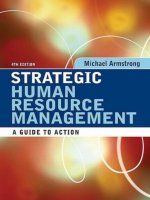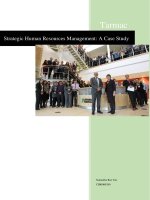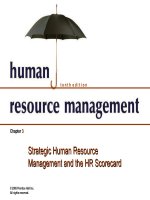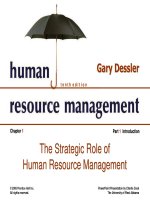Lesson about Strategic Human Resourse Management - Chap 02
Bạn đang xem bản rút gọn của tài liệu. Xem và tải ngay bản đầy đủ của tài liệu tại đây (472.49 KB, 14 trang )
CHAPTER 2
Organisational strategy, structure,
culture and policy
Session objectives
Explain the concepts and characteristics of SHRM
Understand the relationships between SHRM and
business strategies
Appreciate the various critiques of SHRM
Discuss several models of SHRM
Explain the relationships between SHRM and
organisational strategy, structure, culture and policy
Discuss the roles and structures of HR functions
SHRM and business strategy
HR and organisational strategy
linkages:
Accommodative
Interactive
Fully integrated
Critics of SHRM
Can
SHRM adopt a flexible and
strategic perspective?
Can practitioners implement the
SHRM agenda?
SHRM – strategy, structure,
culture and policy
Relationships:
Culture
Strategy
Structure
The ‘flexible firm’ model
Numerical
flexibility
Functional flexibility
Distancing
Pay flexibility
Organisational culture and HRM
Organisational
culture includes philosophies,
values, beliefs, work systems and practices,
expectations and limitations on employee
behaviour
Four broad types:
– Elite
– Meritocratic
– Collegial
– Leader-focused
Cultural change
Excellence theorists believe that culture can
be modified to achieve efficiency/profitability
Structural efficiency principle (SEP) and
Award restructuring put pressure on
organisations to change work practices and
modify traditional cultures
HR specialist drives the process
Change can also result from innovative HR
approaches
Principles of effective HR policies
Congruency
Compatibility
Clarity
Stability
Flexibility
Cultural appropriateness
Relationships
HRM structures
No HR function
Line managers alone
Line managers, with centralised HR
support
Centralised functional generalists
Centralised functional specialists
Decentralised functional generalists or
specialists
Strategic partnerships
The new HR
Devolvement of HRM functions
Joint provision of HR services
Strategic focus of role









